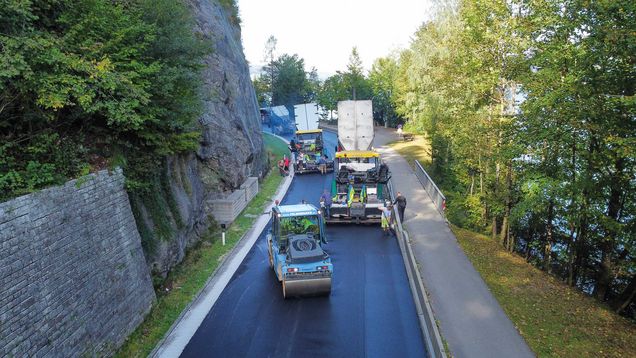Civil engineering deployed for road renovation
October 15, 2021 | Markus Lackner
The project to renovate the approximately three-kilometre stretch of road is part of the Upper Austria Plan for Mobility Infrastructure. "Renovation of the roughly three-kilometre-long section below the so-called "Scharflinghöhe" became necessary due to the heavy volume of traffic. Furthermore, the road had been repeatedly damaged by rock slides and falling rocks says Felbermayr construction manager Martin Haas, when explaining the reasons behind the renovation.
Thermal saddles, road rollers and asphalt mixing plant
At the beginning of the work, roughly ten centimetres of the existing asphalt structure were milled off. The milled surface was then cleaned using a high-pressure sweeper and a bitumen emulsion was applied with a pre-sprayer as a tack coat for the individual asphalt layers, after which a 7.5 centimetre thick asphalt base course was placed on top. "A half-lane closure was sufficient for this work,” reports Haas. This meant that the busy road did not have to be completely closed for the duration of the works.
After four days of paving preparation, the time had come - application of the surface layer could begin. However, this required complete closure of the road and the set-up of a diversion. "This was necessary in order to seamlessly apply the asphalt across the entire width and to achieve as level a finish as possible," explains Haas. Two so-called pavers were used for this, which were arranged slightly offset in parallel. The asphalt surface layer was delivered by 35 thermally insulated trucks. These special trailers are able to keep the material at the necessary processing temperature of about 170 degrees.
This was essential due to the distance of around 80 km from the mixing plant in Haag am Hausruck to the construction site. Otherwise, the asphalt mix would have cooled down too much. Including the base course, roughly 4,700 tonnes of asphalt were laid in total. This corresponds to around 250 truck transports. In order to keep traffic disruptions to a minimum, this construction work was carried out at the weekend.
"The mixing plant has a maximum daily capacity of 2,000 tonnes, while an average of 1,000 tonnes was needed every day," Haas notes; he is delighted to have contributed to road safety on Mondseestraße with the work. The client - the Directorate for Road Construction and Transport: Department of New Road Construction and Maintenance - also has reason to be pleased with the job. The department was delighted with the very high quality of the mix production and mix incorporation.

